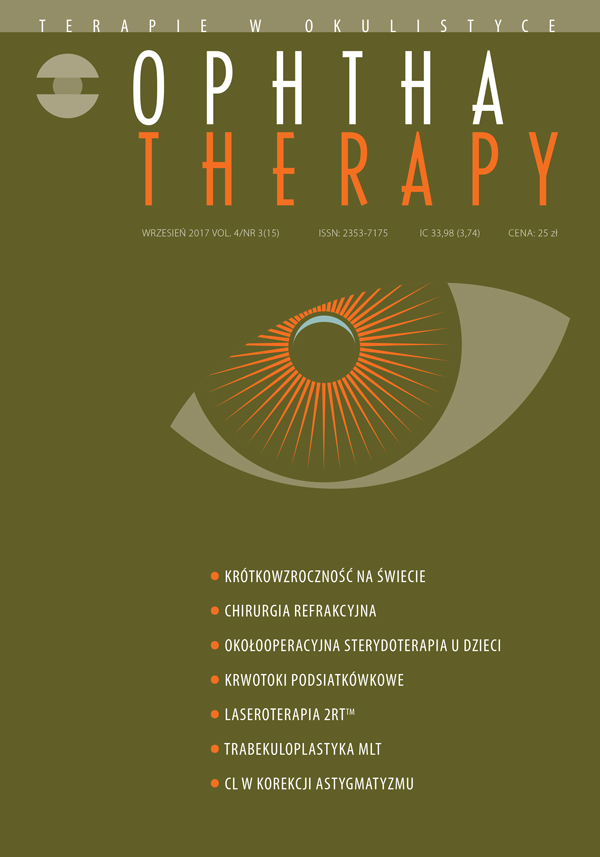Nieprzestrzeganie zaleceń lekarskich przez pacjentów z jaskrą
##plugins.themes.bootstrap3.article.main##
Abstrakt
Nieprzestrzeganie zaleceń lekarskich w terapii jaskry ogranicza skuteczność leczenia i prowadzi do progresji choroby.
Cel: Analiza współpracy pacjentów z jaskrą metodami subiektywną i obiektywną.
Materiał i metody: Badaniem objęto 127 pacjentów z jaskrą. Subiektywna ocena compliance została przeprowadzona przy użyciu ankiety złożonej z 2 pytań. Odpowiedzi 28 pacjentów zostały dodatkowo zweryfikowane za pomocą urządzenia Travalert Dosing Aid®.
Wyniki: Stosowanie się do zaleceń oszacowane za pomocą aparatu Travalert® było dużo niższe niż określone w ankiecie (57% vs 93%; p = 7,896 × 10-16).
Wnioski: Lekarze leczący jaskrę powinni mieć świadomość, że subiektywna metoda pomiaru compliance jest niemiarodajna. Nie należy podejmować decyzji terapeutycznych wyłącznie na podstawie wyników kwestionariusza samooceny.
Pobrania
##plugins.themes.bootstrap3.article.details##

Utwór dostępny jest na licencji Creative Commons Uznanie autorstwa – Użycie niekomercyjne – Bez utworów zależnych 4.0 Międzynarodowe.
Copyright: © Medical Education sp. z o.o. License allowing third parties to copy and redistribute the material in any medium or format and to remix, transform, and build upon the material, provided the original work is properly cited and states its license.
Address reprint requests to: Medical Education, Marcin Kuźma (marcin.kuzma@mededu.pl)
Bibliografia
2. Kingman S. Glaucoma is second leading cause of blindness globally. Bull World Health Organization 2004; 82(11): 887-8.
3. European Glaucoma Society. Terminology and guidelines for glaucoma. The fourth edition. Dogma, Savona, Italy 2014: 1-191.
4. Quigley H, Broman A. The number of people with glaucoma worldwide in 2010 and 2020. Br J Ophthalmol. 2006; 90(3): 262-7.
5. Postępowanie w jaskrze – wytyczne Polskiego Towarzystwa Okulistycznego 2017 r. Online: http://pto.com.pl/wytyczne.
6. Cate H, Bhattacharya D, Clark A et al. A comparison of measures used to describe adherence to glaucoma medication in a randomised controlled trial. Clin Trials. 2015; 12(6): 608-17.
7. Olthoff CM, Schouten JS, van de Borne BW et al. Noncompliance with ocular hypotensive treatment in patients with glaucoma or ocular hypertension an evidence-based review. Ophthalmology. 2005; 112(6): 953-61.
8. Osterberg L, Blaschke T. Adherence to medication. N Engl J Med. 2005; 353(5): 487-97.
9. Friedman DS, Jampel HD, Congdon NG et al. The Travatan Dosing Aid accurately records when drops are taken. Am J Ophthalmol. 2007; 143(4): 699-701.
10. Tsai J, McClure C, Ramos S et al. Compliance barriers in glaucoma: a systemic classification. J Glaucoma. 2003; 12(5): 393-8.
11. Kholdebarin R, Campbell R, Jin Y et al. Multicenter study of and drop administration in glaucoma. Can J Ophthalmol. 2008; 43(4): 454-61.
12. Okeke C, Quigley H, Jampel H et al. Adherence with topical glaucoma medication monitored electronically the Travatan Dosing Aid Study. Ophthalmology. 2009; 116(2): 191-9.
13. Sabate E, De Geest S. Adherence to Long-Term Therapies: Evidence for Action. Eur J Cardiovasc Nurs. 2003; 2(4): 323.
14. Bansal R, Tsai J. Compliance/Adherence to Glaucoma Medications – A Challenge. J Curr Glaucoma Pract. 2007; 1(2): 22-5.
15. Sitek A, Turkiewicz J. Co pacjenci myślą o lekarzach? Gazeta Lekarska. 2016; 3: 44-5.

